Reports
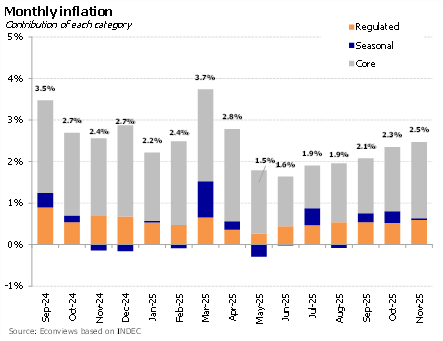
November’s inflation print came in broadly in line with expectations, but it still raised a yellow flag. It is not alarming for now, although the trend over the past six months has clearly been upward. Core inflation, which better captures underlying dynamics, rose to 2.6%, its highest level since April, and year-on-year inflation accelerated for the first time during the Milei administration.

Abriendo mercados. Después de más de 7 años, el Tesoro volvió a emitir deuda en dólares. Se colocaron unos US$ 1,000 millones nominales (US$ 910 millones cash) y la tasa resultó en 9.26%. Se esperaba algo mejor, sobre todo considerando los cambios regulatorios que buscaban incentivar la demanda y lograr un costo más bajo. De todos modos, es un primer paso positivo para reabrir los mercados. Vendrán más.
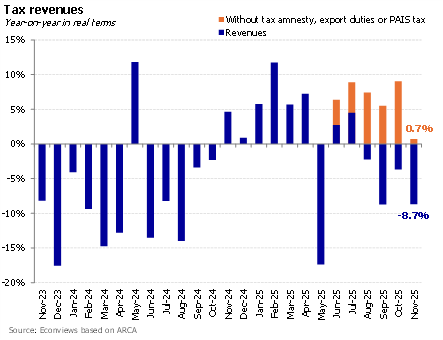
As we anticipated in our last editorial, the government announced with great fanfare that Argentina will once again place dollar-denominated debt. The January maturities accelerated the timeline, and “Toto” decided to step onto the field to seek financing in the local market.
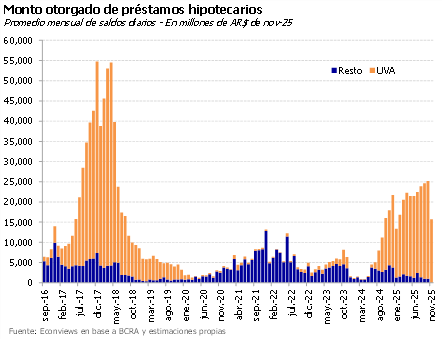
El gobierno prepara la cancha para diciembre. Es un mes particular porque la economía necesita más dinero por el pago de aguinaldos y los gastos de las fiestas y vacaciones. Al mismo tiempo, el Tesoro enfrenta vencimientos de deuda en pesos por AR$ 40 billones, de los cuales unos AR$ 13 son con el sector privado. Esto podría llevar a que enfrentemos una escasez de pesos en el mercado. Para prevenir esto, el Gobierno ha tomado algunas medidas que liberaron liquidez a los bancos. El juego es fino, porque a fines de enero típicamente suele caer la demanda de pesos y puede haber presión sobre el tipo de cambio.
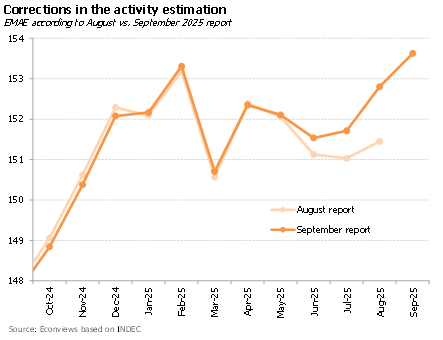
As the year-end toast approaches, the market is beginning to eye the January calendar with some concern. And with good reason: Argentina faces capital and interest maturities in foreign currency totaling around USD 4.2 billion, and the Treasury’s dollar coffers are empty. There is no time to buy dollars in the market, nor has the Government signaled any desire to move in that direction. Therefore, the strategy will focus on securing financing—terrain where “Toto’s” team has shown a very deft hand.
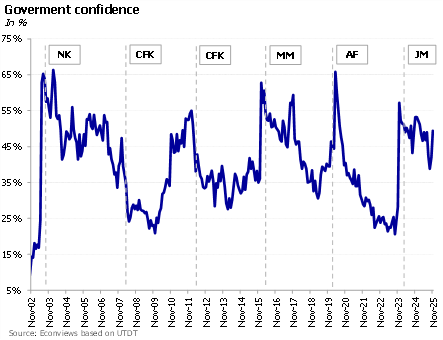
To begin with, La Libertad Avanza increased its representation in both chambers of Congress. In the Lower House it is now the largest bloc, with roughly 90 seats—plus additional support from PRO and other parties aligned with the government. In the Senate its representation also grew, and, most importantly, Peronism will not hold a majority in that chamber for the first time since the return of democracy. These numbers pave the way for the approval of the budget and put the government in a stronger negotiating position to advance labor and tax reforms.
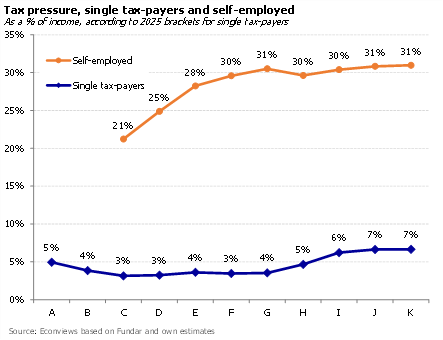
Rates keep falling. Short-term interest rates (repos and caución) have stabilized around 20%, with the Central Bank lowering the floor to 20% in the simultáneas (reverse repo) operations market. This pulled the rest of the curve downward and improves the rate at which the Treasury will be able to roll over its debt in tomorrow’s debt auction. The TAMAR rate is already trading near 33% (down from over 60% before the elections), and overdraft rates have fallen to around 38%. Credit is recovering only modestly in November, but it will likely accelerate in the coming months.
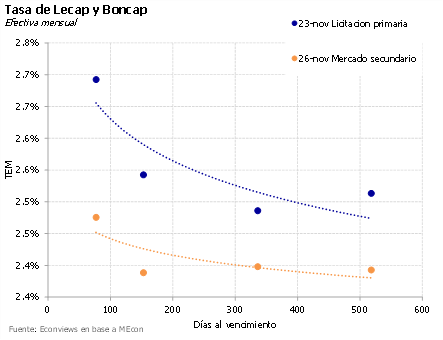
El Tesoro pasó una licitación exigente. Renovó el 96% de los $ 14.6 billones que vencían (contando con sólo $ 5 billones depositados en el BCRA para afrontar pagos). Para apuntalar el resultado, el BCRA había recortado la tasa de simultáneas e incrementado la porción de encajes que pueden integrarse con títulos públicos. Las tasas salieron con un premio lógico respecto del secundario y se logró alargar los plazos, un paso clave para normalizar el mercado de pesos y ordenar el legado post-LEFIS.

The framework agreement on trade and investment with the United States was finally announced. It is not a free trade agreement nor a deep accord endorsed by the Congresses of both countries, but rather a government-to-government understanding aimed at boosting the bilateral relationship and strengthening U.S. influence in Argentina, which Washington views as a strategic geopolitical ally.
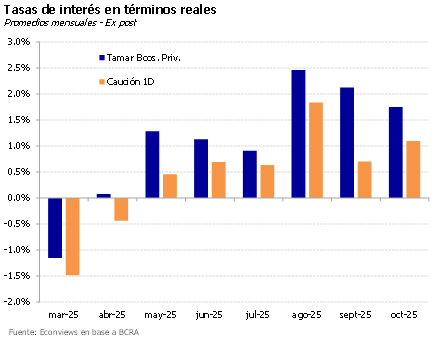
Sigue la ayuda del tío Scott. Finalmente, Bessent confirmó que se activó un tramo del swap, tal como anticipábamos la semana pasada al analizar el balance del BCRA. El monto rondaría los US$ 2,700 millones e incluiría tanto los dólares que utilizó el Tesoro de EE.UU. para intervenir en el MULC como los fondos destinados a cubrir el vencimiento con el FMI de la semana pasada. Según los datos disponibles, el BCRA habría recibido DEGs de EE.UU. y se los habría vendido al Tesoro argentino para efectuar el pago al Fondo.
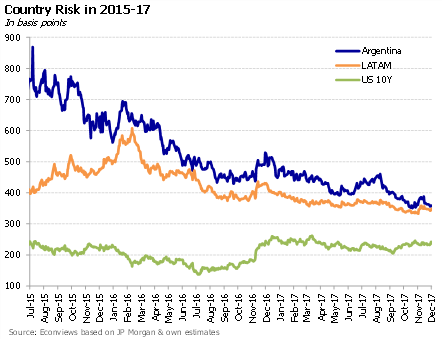
Milei’s economic program seems to have entered a new phase. After the confidence shock triggered by the election victory, signs of a more normalized economy are starting to appear, with interest rates falling to more sustainable levels — both for public debt and for overall economic activity.
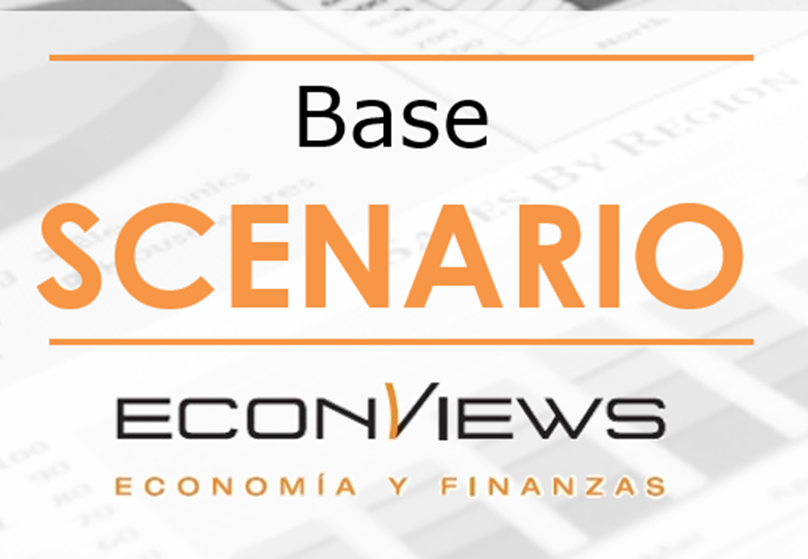
The midterm elections reshaped the outlook for both the government and the markets. The result can be seen as a strong rejection of Kirchnerism and, at the same time, as a mandate to govern. In Congress, the administration now has the opportunity to move from defense to offense. The resounding national victory leaves it in a stronger position to advance discussions on labor, tax, and pension reforms.

- Normalizando las tasas. Después del fuerte apretón monetario previo a las elecciones, las tasas de interés comenzaron a acomodarse en niveles más razonables en los últimos días. La semana pasada, el Tesoro liberó unos AR$ 5 billones en la licitación de deuda y aportó liquidez comprando bonos en el mercado secundario, lo que contribuyó a la baja de las tasas. En la misma dirección se movió el BCRA, que redujo la tasa de la rueda repo del 25% al 22%, estableciendo un nuevo piso para las tasas cortas y arrastrando a las tasas pasivas. Las tasas activas también están descendiendo, aunque a un ritmo más lento.
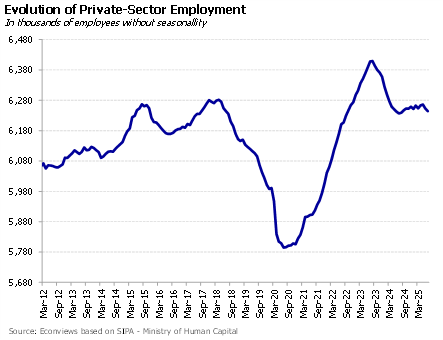
The surprising and impressive victory of LLA in the elections completely reshaped the political and economic landscape. The ruling coalition exceeded its minimum goal (securing one-third of the Lower House) and, together with PRO, also achieved one-third of the Senate—leaving Peronism without a majority in that chamber for the first time since the return of democracy.
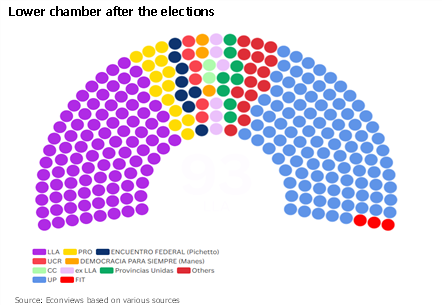
The government’s victory in the mid-term election was a game changer. The LLA got 40% of the national vote and achieved its goal of reaching one-third of Congress in both chambers (enough to sustain possible vetoes to opposition populist initiatives). With its alliance with PRO, it now has 104 Congressmen in the lower House, more than the Peronists, thus becoming the largest minority.
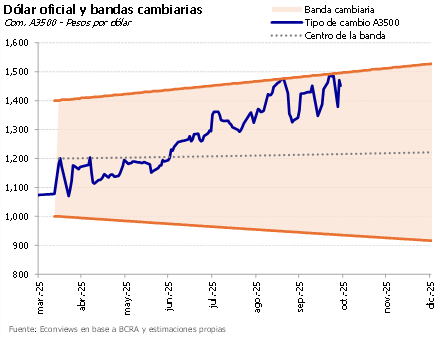
El impactante triunfo de LLA en las elecciones del domingo cambió el panorama político. El resultado puede leerse como un fuerte rechazo al kirchnerismo y, al mismo tiempo, como un mandato de gobernabilidad. En el Congreso, el Gobierno tiene ahora la posibilidad de pasar de la defensiva a la ofensiva. Con los vetos garantizados, podrá frenar cualquier embate opositor. Pero además, ambas cámaras quedarán sin mayorías absolutas y relativamente equilibradas. Esto invita al Ejecutivo a impulsar reformas, para lo cual deberá construir consensos con los partidos del centro dialoguista y con los gobernadores. En enero comenzará la discusión por la reforma laboral y tributaria.
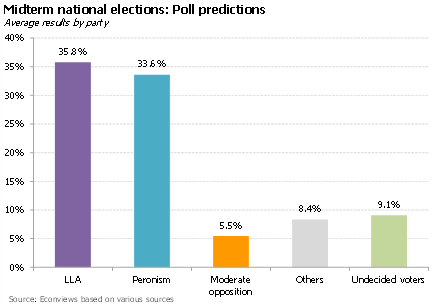
Election day has finally arrived. The government managed to keep the dollar within the target band, even if the exchange rate stayed close to its upper limit. To do so, it had to sweat it out and rely on support from the U.S. Treasury, which sold a significant amount of dollars. Still, that help wasn’t enough to reverse the rise in country risk—now around 1,100 basis points—or to restore confidence in the government’s economic program.
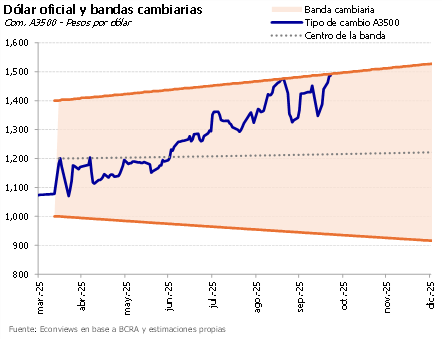
Sensaciones en la previa de las elecciones. La economía llega a las elecciones con incertidumbre y el antecedente de lo que pasó en la Provincia de Buenos Aires. Sin embargo, el pesimismo parece haberse moderado en los últimos días, a medida que el mercado fue internalizando dos cuestiones. Primero, que, salvo una catástrofe electoral, las encuestas indican que LLA + PRO deberían alcanzar al menos un tercio de las bancas en Diputados, un objetivo mínimo para contener los embates de la oposición. En segundo lugar, que el programa económico posterior a las elecciones contaría con un apoyo sin precedentes de Estados Unidos. De todos modos, el mercado y los privados prefieren llegar cubiertos y superdolarizados al domingo. El recuerdo de las PASO 2019 y septiembre 2025 todavía está fresco. Pero también influye la pérdida de confianza en el programa, la debilidad del esquema cambiario y monetario, y la expectativa de que haya cambios en este frente.

The economy remains in a state of turbulence as the country prepares for the legislative elections. While inflation is still under control and no one doubts that fiscal balance will be maintained, concerns persist about the exchange rate, the stagnation of domestic demand, the Central Bank’s lack of control over both the level and volatility of interest rates —which have reached absurd levels— and a country risk that remains sky-high.

El mercado, al vaivén de los anuncios. El Tesoro de Estados Unidos viene redoblando la apuesta para “rescatar” a la Argentina, haciendo movimientos que hasta ahora ningún gobierno americano había hecho en la Argentina. El jueves pasado vendió dólares para sostener el tipo de cambio y ayer volvió a intervenir, colocándose en pesos. También anunció un swap de monedas por 20,000 millones de dólares y que el sector privado estaba armando un paquete por un monto similar, lo que (de concretarse) implicaría un programa de ayuda nunca visto. El impacto inicial fue una fuerte baja del riesgo país. Pero las dudas regresaron el martes, cuando Trump declaró (en la reunión bilateral en la que se esperaban más detalles del apoyo estadounidense) que la ayuda estaba condicionada a que Milei gane las elecciones, lo que generó confusión y un nuevo derrumbe en los mercados.
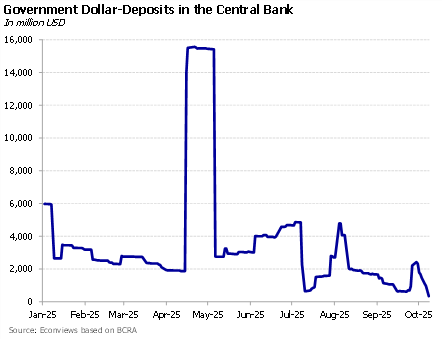
When everything seemed to be spiraling out of control, the “American rescue” reappeared. Until las Thursday afternoon, the Argentine Treasury had been losing dollars at a worrying pace: it sold almost everything it had bought at the end of September to contain the dollar, and the Central Bank was preparing to step in. But as soon as the rumor spread that the agreement with the U.S. Treasury had been sealed, bonds, stocks, and the exchange rate all breathed a sigh of relief.

The elections in the Province of Buenos Aires were a serious setback for the government. On top of that, internal political tensions and economic uncertainty surged last week. We assume that the outcome of the national elections will be more balanced and that the market will perceive it as neither particularly positive nor negative.
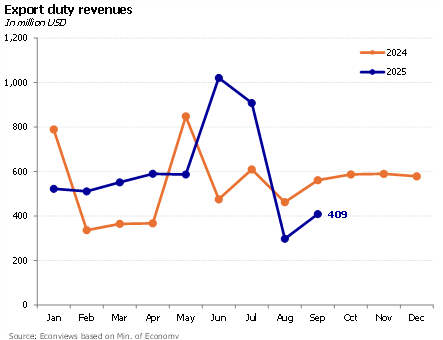
The government has entered survival mode, taking risks that could mortgage the future. Trump’s rescue package created the conditions to accumulate dollars, especially since it was accompanied by the temporary elimination of export taxes on the agricultural sector. The farm sector delivered, with USD 6.3 billion in export proceeds, but only about USD 2.3 billion made it into reserves. The rest was used to hold down the exchange rate. That was hardly what the IMF or the U.S. Treasury had in mind, and it raises doubts about how many dollars will be left for later in the year.
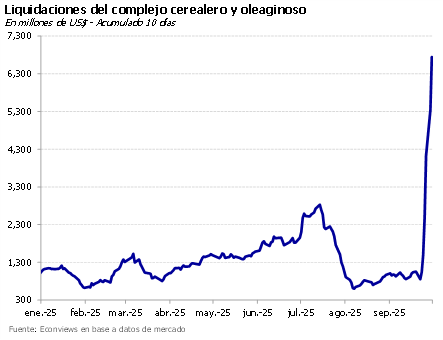
El shock de confianza duró poco. El respaldo de Estados Unidos fue contundente, pero los anuncios resultaron difusos: se mencionaron múltiples mecanismos sin definiciones concretas y sin aclarar si la ayuda dependía o no del resultado electoral. Al mismo tiempo, se agotó el ingreso extraordinario de divisas por la baja temporal de retenciones. De los USD 6,300 millones liquidados, el Tesoro apenas compró alrededor de USD 2,300 millones, lo que dejó un sabor a poco. Todo indica que las tensiones financieras irán en aumento.
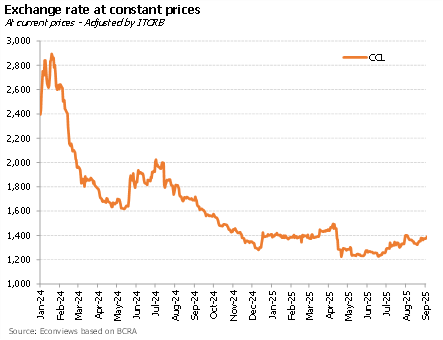
After the storm came some relief, thanks to the United States and the farm sector. Once again, the Government pulled an ace from its sleeve to avoid what could have been the beginning of a crisis. A window of opportunity has opened. The question is whether this time the Government will know how to use it.

Estados Unidos y el campo traen dólares y alivio. Finalmente llegó el alivio financiero con dos noticias clave: el fuerte respaldo de Estados Unidos al gobierno de Milei y la baja temporal de retenciones al agro. Estos anuncios descomprimieron el tipo de cambio, hicieron caer con fuerza el riesgo país y evitaron lo que podría haber sido el inicio de una crisis. El gobierno llega más aliviado a las elecciones, aunque la volatilidad seguirá presente. Se abre así una oportunidad para recalibrar el programa: acumular reservas, pasar a un tipo de cambio más flexible y competitivo, y mejorar el esquema monetario. De no avanzar en esa dirección, el gobierno solo habrá pateado el problema hacia adelante.

The economic outlook has deteriorated exponentially in recent days. The poor election result in Buenos Aires Province laid bare the main weaknesses of Milei’s program: politics and reserves. Meanwhile, the government insists that the problem stems solely from the so-called “kuka risk” (political risk). The situation was becoming critical, and with today’s announcements, the government has bought itself some time. But the need to recalibrate the program remains.

Un presupuesto demasiado optimista, pero con metas cumplibles. El lunes el gobierno envió la ley de leyes al Congreso, proyectando un superávit primario de 1.2% del PBI y equilibrio fiscal. Entre los supuestos macro para el año que viene están un crecimiento de 5%, inflación del 10% o un dólar a 1,423 en diciembre de 2026, muy lejos del consenso del mercado o el REM. También anunció un aumento de 5% real para los jubilados, aunque no explicó cómo. En nuestra opinión, los números de recaudación son exagerados y el uso de letras capitalizables esconde el costo real de las tasas positivas en el resultado financiero, pero aún con estos matices, no debería peligrar el superávit primario en 2026. Sí es posible que, ajustando por los intereses, haya un leve déficit financiero, pero hoy el ojo del mercado no está puesto en las cuentas públicas. Los vetos rechazados por el Congreso dan una señal política, pero no mueven demasiado la aguja del gasto.

The election in the province of Buenos Aires changed everything. Stocks plummeted, with bank shares falling by as much as 25%, while country risk climbed above 1,100 basis points, effectively ruling out any chance of market access in the coming months. The good news was that the exchange rate did not skyrocket. It initially depreciated by 4%, but over the following days it continued to rise, closing last week at ARS 1,447—just 1.3% below the upper limit of the currency band (ARS 1,467). Clearly, not everything is going according to plan anymore.

